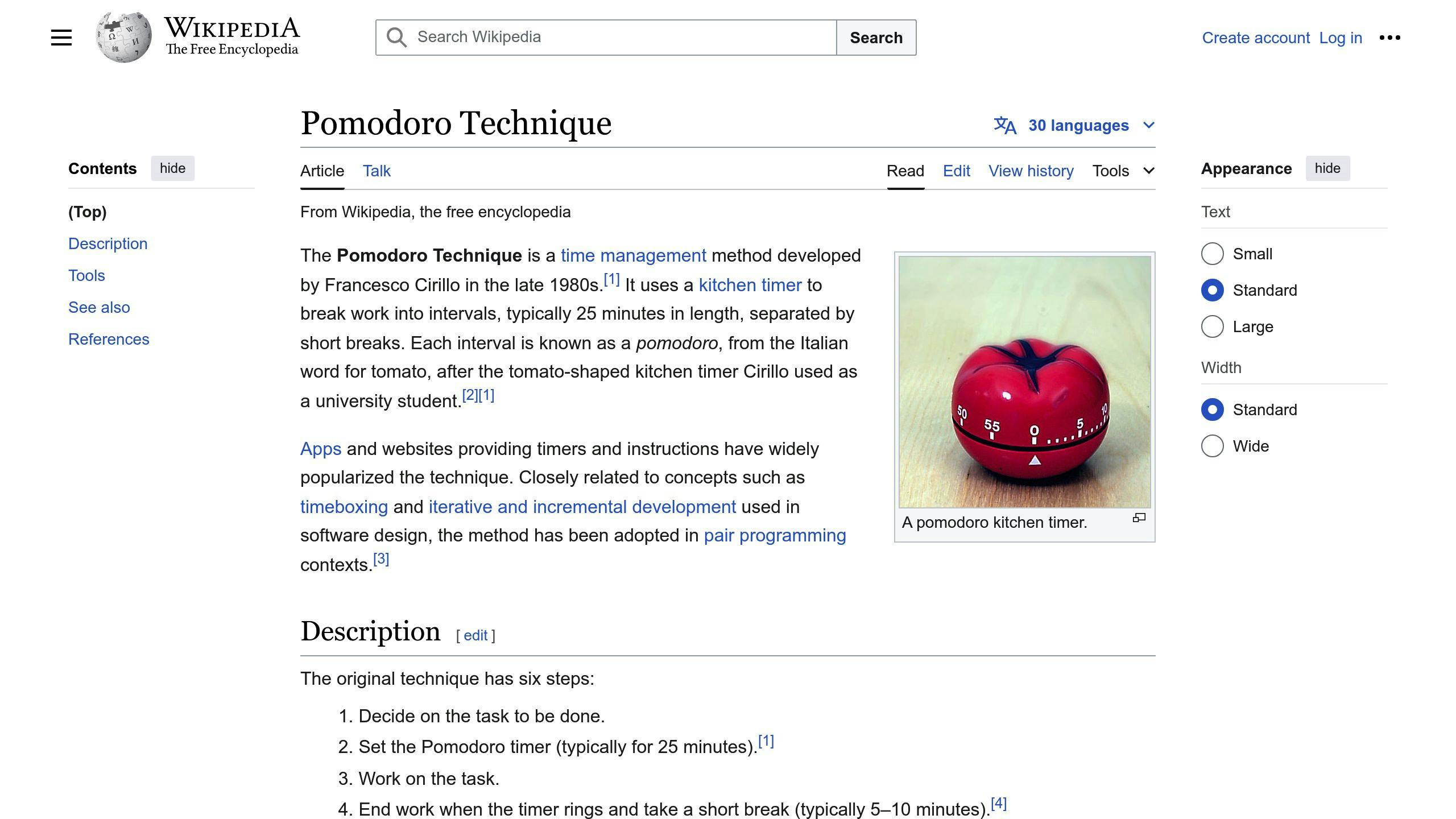The Pomodoro Technique can boost your homeschooling productivity. Here's what you need to know:
- Work in short bursts (usually 25 minutes)
- Take quick breaks (about 5 minutes)
- Adjust timings for your child's age
- Use a simple timer
- Apply to different subjects
Key benefits for homeschoolers:
- Improves focus
- Breaks tasks into manageable chunks
- Maintains energy with regular breaks
- Increases study efficiency
Here's a quick guide for different age groups:
| Age Group | Work Time | Break Time |
|---|---|---|
| 5-10 years | 10-15 mins | 5 mins |
| 10-13 years | 20 mins | 5 mins |
| 14+ years | 25 mins | 5 mins |
Ready to start? Here's how:
- Pick a task
- Set your timer
- Focus until it rings
- Take a breather
- Repeat
Start with one or two sessions daily and increase as your child gets comfortable. Remember, the Pomodoro Technique is flexible - adjust it to fit your family's needs.
Related video from YouTube
Basics of the Pomodoro Technique

The Pomodoro Technique is a time management method that can help homeschoolers focus better and get more done. Here's what you need to know:
Who created it and when
Francesco Cirillo, an Italian student, came up with the Pomodoro Technique in the late 1980s. He used a tomato-shaped kitchen timer to break his study time into chunks. That's why it's called "pomodoro" - it means "tomato" in Italian.
Main parts of the method
The Pomodoro Technique is pretty simple:
- Work for 25 minutes
- Take a 5-minute break
- After four work sessions, take a longer 15-30 minute break
Here's what it looks like:
| Step | What to do | How long |
|---|---|---|
| 1 | Focus on work | 25 minutes |
| 2 | Short break | 5 minutes |
| 3 | Focus on work | 25 minutes |
| 4 | Short break | 5 minutes |
| 5 | Focus on work | 25 minutes |
| 6 | Short break | 5 minutes |
| 7 | Focus on work | 25 minutes |
| 8 | Long break | 15-30 minutes |
To use the technique:
- Pick a task
- Set a timer for 25 minutes
- Work until the timer goes off
- Take a break
- Do it again
For younger kids, you can adjust the work time:
| Age | Work time | Break time |
|---|---|---|
| 5-10 years | 10-15 minutes | 5 minutes |
| 10-13 years | 20 minutes | 5 minutes |
| 14+ years | 25 minutes | 5 minutes |
"For younger students, a good rule is to focus for their age plus one minute. But by 15, they should be able to do a full 25-minute Pomodoro." - Uncommon Sense Teaching MOOC course
How Pomodoro helps homeschooling
The Pomodoro Technique can supercharge your homeschooling. Here's why:
Kids focus better
Let's face it: kids aren't great at focusing for hours. Pomodoro breaks study time into bite-sized chunks. It's like giving their brain a series of small, manageable tasks instead of one big, scary one.
Check out these age-based Pomodoro times:
| Age | Work time | Break time |
|---|---|---|
| 5-10 years | 10-15 minutes | 5 minutes |
| 10-13 years | 20 minutes | 5 minutes |
| 14+ years | 25 minutes | 5 minutes |
This isn't just random. It's based on how long kids can actually focus. Roxana Murariu, a Pomodoro-loving homeschool mom, says:
"I aim for one, maybe two, Pomodoro sessions of six minutes during weekdays. On weekends, I aim for two, maybe three, Pomodoro sessions."
With Pomodoro, kids learn to tune out distractions and zero in on their work. They know a break is coming soon, so it's easier to stay on track.
Kids get less tired
Long study sessions? They're a recipe for burnout. Pomodoro throws in regular breaks to keep kids fresh. During these mini-breaks, kids can:
- Stretch
- Grab a drink
- Do a quick dance (or whatever gets them moving)
These little pauses are like hitting the reset button on their brain and body.
Francesco Cirillo, the Pomodoro mastermind, puts it this way:
"By following timed intervals with planned breaks, you can get better 'buy-in' from your child and help them grow to understand how long certain tasks take for them."
Bonus: Pomodoro teaches kids about time management. They learn to work hard during focus time and enjoy guilt-free breaks. It's a win-win!
Changing Pomodoro for homeschool use
The Pomodoro Technique is great, but it's not perfect for everyone. Here's how to make it work for your homeschool:
Changing time periods
25 minutes of work and 5 minutes of break? That's not always ideal for kids. Try these instead:
| Age | Work time | Break time |
|---|---|---|
| 5-7 | 6-8 minutes | 2-3 minutes |
| 8-10 | 10-15 minutes | 3-5 minutes |
| 11-13 | 20 minutes | 5 minutes |
| 14+ | 25 minutes | 5 minutes |
But don't treat these as set in stone. Watch your kid and adjust as needed.
Roxana Murariu, a homeschooling mom, does it this way:
"I aim for one, maybe two, Pomodoro sessions of six minutes during weekdays. On weekends, I aim for two, maybe three, Pomodoro sessions."
Got older kids or tough tasks? You might go up to 45 minutes. It's all about finding what clicks for your child.
Break time activities
Breaks aren't just downtime - they're recharge time. Try these:
- Stretching
- Jumping jacks
- Healthy snacks
- Quick dance breaks
- Deep breaths
Leighann Marquiss, another homeschool parent, has a trick:
"If my kids are constantly at me with grumbling and complaining (I'm bored, there's nothing to do, etc) the first thing I do is give them a chore, the second is set the timer and tell them they can't come back to complain until the timer goes off. It works like a charm to get them focused on something to do while the time ticks down."
Got a kid with ADHD? Think about shorter work times with quick 1-2 minute breaks. It can help keep their focus in check.
sbb-itb-fb77983
How to start using Pomodoro
Starting with the Pomodoro Technique for homeschooling is easy. Here's what you need:
Tools you need
You'll need a timer. Options include:
- Kitchen timer
- Smartphone app
- Online timer
- Smart assistant
Tip: Skip the phone if you can. It's too distracting.
For kids who learn visually, try a YouTube video with a timer.
Setting up the study area
Create a focused space:
- Pick a quiet spot
- Clear out distractions
- Gather study materials
- Put the timer where everyone can see it
Pro tip: Use a physical timer or smart assistant. Phones can die or distract.
Introducing the technique to kids:
- Start small (5-10 minutes)
- Slowly increase time as they get used to it
- Match work periods to their age
| Age | Work time | Break time |
|---|---|---|
| 5-7 | 6-8 min | 2-3 min |
| 8-10 | 10-15 min | 3-5 min |
| 11-13 | 20 min | 5 min |
| 14+ | 25 min | 5 min |
Alex Ortiz, a homeschooling parent, says:
"If you're struggling with productivity at home, give this a shot. It's flexible, and once everyone gets used to the timer, you'll see great results."
Step-by-step guide to using Pomodoro
Planning the day
1. List tasks
Write down all homeschool subjects and activities for the day.
2. Prioritize
Order tasks by importance and difficulty.
3. Assign Pomodoros
Allocate Pomodoro sessions to each task. For younger kids, use shorter work periods.
| Age | Work time | Break time |
|---|---|---|
| 5-7 | 6-8 min | 2-3 min |
| 8-10 | 10-15 min | 3-5 min |
| 11-13 | 20 min | 5 min |
| 14+ | 25 min | 5 min |
4. Schedule breaks
Plan short breaks between Pomodoros and longer breaks after 3-4 sessions.
5. Prepare materials
Gather all needed supplies before starting.
Staying on task
Set the timer, remove distractions, and focus on one task at a time. Use breaks to refresh and track your progress. Be flexible with time periods based on your child's focus ability.
Roxana Murariu, an author experienced with the Pomodoro technique in homeschooling, says:
"I aim for one, maybe two, Pomodoro sessions of six minutes during weekdays. On weekends, I aim for two, maybe three, Pomodoro sessions."
Remember: The Pomodoro technique isn't set in stone. Adjust it to fit your family's needs and watch your homeschooling productivity soar!
Fixing common problems
Handling distractions
Distractions can kill your Pomodoro flow. Here's how to stay focused:
-
Create a distraction-free zone: Silence your phone, close unnecessary tabs, and tell people not to bug you.
-
Use a notebook: Keep one nearby to jot down random thoughts. Then get back to work.
-
Set clear boundaries: Tell your family when you're in Pomodoro mode. Example: "I'm focusing from 10-11 AM and 2-3 PM."
-
Address internal distractions: Teach kids to ignore the urge to do other stuff during a Pomodoro.
Getting used to the system
New to Pomodoro? Here's how to make it stick:
- Start small: Begin with shorter work periods. Use this guide:
| Age | Work time | Break time |
|---|---|---|
| 5-7 | 6-8 min | 2-3 min |
| 8-10 | 10-15 min | 3-5 min |
| 11-13 | 20 min | 5 min |
| 14+ | 25 min | 5 min |
-
Make it visual: Use colorful timers or apps to make it fun for kids.
-
Involve children: Let them pick tasks or set the timer.
-
Gamify it: Create a reward system for completing Pomodoros.
-
Be flexible: Adjust the technique to fit your family's needs. Roxana Murariu, a homeschooling parent, says:
"I aim for one, maybe two, Pomodoro sessions of six minutes during weekdays. On weekends, I aim for two, maybe three, Pomodoro sessions."
- Create a routine: Start homework at the same time each day using Pomodoro.
Advanced Pomodoro tips for homeschoolers
Pomodoro for different subjects
Tailor Pomodoro times to each subject:
| Subject | Work time | Break time |
|---|---|---|
| Math | 30 min | 7 min |
| Reading | 20 min | 5 min |
| Science | 25 min | 6 min |
| Art | 40 min | 10 min |
Tough subjects? Use shorter work periods. Fun topics? Go for longer sessions.
Mixing Pomodoro with other methods
Let kids work until they need a break. Track focus time to improve future sessions.
2. Time Blocking
Schedule Pomodoro sessions for each subject throughout the day.
3. 90/30 Technique
Use 90-minute work blocks with 30-minute breaks for older students or big projects.
4. Animedoro
Try 40-60 minute work sessions followed by a short TV episode as a reward.
Francesco Cirillo, the Pomodoro Technique creator, says: "The Pomodoro Technique shouldn't be rigid. It's a tool to help you, not to control you."
Remember: Pomodoro is flexible. Adjust it to fit your homeschooling needs.
Conclusion
The Pomodoro Technique can supercharge your homeschooling. Here's the gist:
- Work in short bursts (usually 25 minutes)
- Take quick breaks (about 5 minutes)
- Tweak times for your kid
- Use a simple timer
- Apply to different subjects
Ready to start? Here's how:
- Pick a task
- Set your timer
- Focus until it rings
- Take a breather
- Repeat
Begin with one or two sessions daily. Ramp up as your child gets comfy with it.
"The Pomodoro Technique is a helper, not a boss." - Francesco Cirillo, the guy who came up with it


